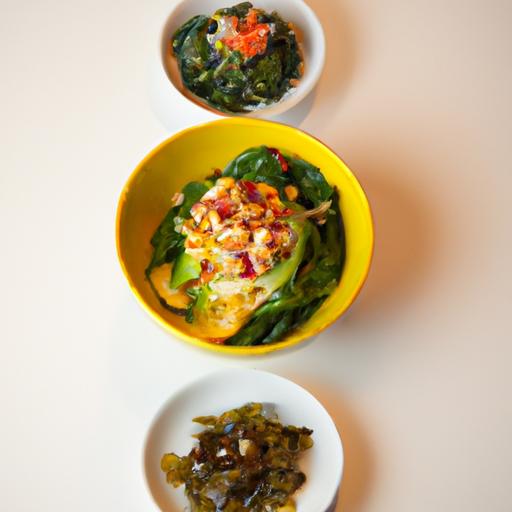In the vibrant world of Korean cuisine, kimchi reigns supreme-a fermented masterpiece that teases the tongue with its tangy crunch and fiery kick. But what happens when that cherished jar of kimchi falls flat, missing the spark that sets it ablaze with spicy heat? Fear not, adventurous eaters and home fermenters alike. Whether your kimchi turned out too mild or lost its punch over time, there are exciting ways to reignite that signature fire. In this article, we’ll explore creative techniques and clever tips to boost your fermented spice, transforming a lackluster batch into a bold, blazing condiment that commands attention at every meal. Prepare to turn up the heat and revive the soul of your kimchi!
When Kimchi Lacks Fire: Boosting Your Fermented Spice
When kimchi lacks fire, it’s an opportunity to creatively ignite the layers of flavor in this beloved Korean staple. Traditional fermentation relies heavily on the delicate balance of heat and spice, but by understanding the role of heat and exploring dynamic spice profiles, you can amplify your kimchi’s kick, resulting in an irresistibly bold and vibrant condiment. Let’s dive deep into how heat transforms texture and taste, which ingredients bring the most impactful heat, and the fermentation secrets that make your spicy kimchi sing.
Prep and Cook Time
- Preparation: 30 minutes
- Fermentation: 5 to 7 days (room temperature), additional 2 weeks refrigerated aging recommended
Yield
- Approximately 1 quart (serves 4 to 6)
Difficulty Level
- Medium – requires patience and attention during fermentation, but very beginner-friendly otherwise
Ingredients
- 1 medium Napa cabbage (about 2 to 2.5 pounds), quartered
- 1/2 cup sea salt (for salting cabbage)
- 1 cup Korean gochugaru (coarse red chili pepper flakes)
- 1/4 cup fish sauce (for umami depth)
- 1 tablespoon fermented salted shrimp (saeujeot) (optional, for extra complexity)
- 5 cloves garlic, minced
- 1-inch piece fresh ginger, grated
- 1 small onion, finely chopped
- 2 medium green onions, sliced
- 1 Korean radish, julienned
- 1 teaspoon sugar (to help fermentation)
- Water (to rinse and soak cabbage)
Instructions
- Salt the Cabbage: Rinse and drain your Napa cabbage. Cut into quarters and sprinkle between each leaf generously with sea salt. Let it rest for 2 hours, turning the cabbage every 30 minutes to ensure even salting. This step draws out moisture and softens the leaves.
- Prepare the Spice Paste: While your cabbage is soaking, combine gochugaru, fish sauce, minced garlic, grated ginger, chopped onion, saeujeot, and sugar in a bowl. Mix until it forms a slightly chunky, bright red paste. Adjust the pepper flakes if you want to increase the heat.
- Rinse & Drain the Cabbage: Thoroughly rinse the salted cabbage under cold water several times to remove excess salt. Drain well and set aside in a large mixing bowl.
- Mix the Vegetables: Add the julienned Korean radish and sliced green onions to the cabbage. Pour the prepared chili paste over the vegetables.
- Coat Evenly: Wearing food-safe gloves, gently massage the spicy mixture into every leaf and crevice of the cabbage quarters. Ensure each piece is well-coated for balanced heat and flavor.
- Pack for Fermentation: Tightly pack the coated cabbage into a clean, airtight container or fermentation crock, pressing down to eliminate air pockets that can disrupt fermentation.
- Ferment at Room Temperature: Store the container at roughly 65-72°F (18-22°C) for 5 to 7 days. You should observe bubbling and liquid release as fermentation ramps up. Taste daily until your preferred spice level and tanginess develop.
- Cold Aging: Once you’re happy with the fermentation, transfer kimchi to the refrigerator to slow fermentation and deepen the flavors. It’s best after at least 2 weeks but can store up to several months.
Chef’s Notes & Tips for Success
- Adjust gochugaru for your spice tolerance. Start moderate and add more during mixing if you crave extra heat.
- If when kimchi lacks fire you want to experiment, try introducing small amounts of ground black pepper or a dash of Korean chili paste (gochujang) for complementary heat and sweetness.
- Consistent temperature during fermentation is key – too warm speeds sourness; too cold delays flavor development.
- For vegan kimchi, substitute fish sauce and salted shrimp with soy sauce or seaweed broth.
- Wear gloves while mixing paste to protect skin from chili irritation and to keep flavors pure.
- Make ahead tip: Kimchi improves over time-if possible, prepare a batch at least one week before serving.
Serving Suggestions
Layer your spicy kimchi alongside hot bowls of steamed rice and Korean BBQ for a fiery crunch that awakens the palate. Garnish with a sprinkle of toasted sesame seeds and thinly sliced green onions to balance the boldness with a nutty aroma. For a modern twist, mix kimchi into scrambled eggs or use as a spicy topping for fried noodles. The vibrant red hues and piquant aroma will invite eager appetites.

| Nutritional Info (per 100g) | Calories | Protein | Carbs | Fat |
|---|---|---|---|---|
| Kimchi | 40 kcal | 2 g | 7 g | 0.5 g |
Elevate your fermentation game and never wonder when kimchi lacks fire again. Mastering these techniques will give you full control over the layers of heat and spice that make kimchi an unforgettable, fiery delight.
For more insights on Korean culinary traditions and fermentation, check out our Classic Kimchi Recipes page. To deepen your knowledge on fermentation science, visit the ScienceDaily fermentation research article.
Q&A
Q&A: When Kimchi Lacks Fire: Boosting Your Fermented Spice
Q1: Why does my kimchi sometimes turn out bland and lacking that signature spicy kick?
A1: Kimchi’s spicy punch comes primarily from Korean chili flakes (gochugaru). If your kimchi feels timid, it might be due to using mild or old gochugaru, insufficient quantities, or uneven distribution. Also, the fermentation duration and temperature can mellow the heat. Fresh, vibrant chili flakes and proper fermentation are key to that fiery zing.
Q2: How can I amp up the heat in my next batch of kimchi without overpowering its classic flavors?
A2: Start by choosing high-quality, fresh gochugaru with a vibrant red color and a balanced heat profile. You can increase the chili flakes slightly or add a touch of freshly ground Korean red pepper for extra intensity. Including spicy ingredients like minced garlic, ginger, or even a dash of hot pepper paste (gochujang) can enhance depth without drowning the other flavors.
Q3: Is there a way to boost spice in already fermented kimchi?
A3: Absolutely! Stir in freshly ground chili flakes or a spoonful of gochujang to your existing kimchi. Let it sit for a day or two in the fridge to meld the new heat into the flavors. For a quick fiery kick, toss kimchi with fresh chopped chili peppers or spicy sesame oil before serving.
Q4: Can changing fermentation conditions influence the spicy flavor of kimchi?
A4: Yes. Cooler fermentation temps (around 4-8°C) slow down the process, preserving sharper, brighter flavors, including spice notes. Warmer temps speed fermentation and can cause the heat to mellow out as the kimchi sours. Experiment with temperature and fermentation time to find a heat level that suits your palate.
Q5: Are there alternative spices or techniques to add complexity to kimchi’s spiciness?
A5: Definitely! Try layering in toasted chili seeds for a nutty spice, wild Asian chili varieties for unique flavors, or adding crunchy radish and green onions that amplify texture and spice perception. Smoked chili flakes can bring a captivating smoky heat that’s different yet complementary to traditional kimchi.
Q6: How do I maintain balance between spicy heat and fermentation’s tangy flavor?
A6: It’s a dance of ratios and timing. Use fermented shrimp or fish sauce for umami richness that tames excessive heat, and keep chili levels aligned with your desired fermentation length. Taste regularly during fermentation to catch the moment when heat and tang harmonize perfectly.
Q7: Can kimchi’s spice be customized for different spice tolerance levels?
A7: 100%! Kimchi is wonderfully adaptable. For gentle warmth, reduce chili and add mild paprika or sweet red pepper flakes. For fire-lovers, amp up gochugaru, fresh chilies, or even a pinch of ground Sichuan pepper for a numbing heat twist. Your kimchi, your spice adventure!
By understanding the fiery essence and fermentation magic of kimchi, you can boldly turn up the heat or dial it down, crafting a spicy masterpiece that excites your taste buds every time. When kimchi lacks fire, ignite it with knowledge and a sprinkle of creativity!
To Conclude
In the world of kimchi, that signature fiery kick is more than just heat-it’s a vibrant dance of culture, flavor, and fermentation magic. When your batch falls flat on the spice scale, don’t despair; it’s simply an invitation to experiment and elevate. From adjusting pepper varieties to dialing in fermentation time and tweaking seasoning ratios, the path to a bolder bite is wide open. Embrace the alchemy of your kitchen lab, and soon your kimchi will blaze with the spirited fire that has made it a beloved staple across the globe. After all, great kimchi is never just made-it’s crafted, tasted, and perfected, bite by spicy bite.


